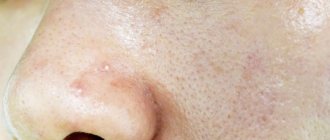A pimple on the gum indicates the need to see a dentist. Unlike acne on the skin, rashes on the mucous membrane cannot be treated on your own. Treatment should be selected by a specialist, taking into account the type and causes of the formation. The mucous membrane is the most favorable environment for the proliferation of harmful microorganisms. By piercing or squeezing such a formation, there is a risk of getting a more serious infection.
A white pimple on the gum indicates an inflammatory process with suppuration inside, but even when there is no suppuration yet, it is better to see a dentist. The problem can be solved with simple home rinses, but there are cases when surgical intervention is necessary.
Pimple on the gum - what to do?
The treatment scenario depends on the reasons that caused the rash on the gums. In addition to clinical treatment, a number of home measures can be taken. For example, if the rash is associated with the spread of Candida fungus in the mouth or with stomatitis, regular rinsing, taking special medications and treating the mucous membrane help. A purulent pimple on the gum may be a consequence of a viral infection of the body, in which case antiviral drugs are prescribed. The treatment must be selected by the dentist. The doctor will explain how to rinse a pimple on the gum and what habits will need to be reviewed. If a rash appears, it is recommended to exclude certain foods from the diet:
- fried foods and dishes high in oil;
- solid foods - nuts, raw vegetables such as carrots, etc.;
- very hot or cold dishes - food should be at room temperature;
- spicy, sweet and sour.
It is important that the diet does not contain foods that can further irritate the mucous membrane. Dentists also recommend abstaining from soda during treatment. Mostly you will need to switch to a liquid diet; you can leave purees and well-cooked porridges.
A white pimple on the gum may be fatty. In this case, the dentist should observe the changes for some time without intervention - the fat will resolve on its own. They rarely increase, but such development is possible. Then surgical removal is necessary.
A rash on the gums may indicate stomatitis, candidiasis or herpetic infection. An individual treatment regimen is selected for each situation. Taking medications is combined with preventive measures such as adjusting the diet. Severe inflammation is treated with a course of antibiotics. If the rash is accompanied by pain in the mouth, the doctor prescribes antiseptic solutions or gels to reduce pain.
What kind of pimple is on the gum?
Only a dentist can accurately diagnose inflammation. Conventionally, rashes are divided into 7 types:
- Transparent. A white bubble on the gum of a child or adult most likely indicates herpetic stomatitis, which occurs due to damage to the body by the herpes virus. Swelling of the mucous membrane can occur in parallel with enlarged lymph nodes and be accompanied by severe itching.
- White. A hard lump that is white or yellowish in color. It may turn out to be a wen that will resolve on its own. If this is him, there will be no other symptoms of inflammation.
- Purulent or bloody inflammations. Most often this is the result of stomatitis, which occurs due to infection in the mucous membrane. The disease appears when there are wounds on the oral mucosa, for example, due to wearing braces. The reasons can also be more trivial - for example, a deep scratch from a fish bone.
- Multiple white pimples on the gums of an adult or child. The pimples themselves or the plaque next to them are white. At the same time, itching is felt in the mouth, sometimes inflammation is accompanied by internal swelling. Such symptoms indicate damage to the oral cavity by Candida fungus.
- Cystic formations. A cyst is a dense lump containing pus inside. It is rarely accompanied by symptoms, but sometimes there is aching pain. The causes are different - from caries and advanced gum inflammation to periodontitis and pulpitis. The cystic tumor is red, but if you press on it a little it turns white due to the pus inside. The size of the cone sometimes reaches a couple of centimeters. The pus inside can destroy bone tissue, so if a cyst-like formation appears, you should immediately make an appointment with a dentist.
- Flux. Inflammation that occurs on the periosteum due to periostitis. In addition to a large white or red pimple, severe inflammation appears. The gum swells and the cheek along with it.
- Abscess. The last stage to which a cyst, flux or purulent formation develops. The pus inside the inflamed tissue destroys it and a cavity appears. Due to the abscess, fistulas appear - these are channels for the removal of pus. They look like holes or pimples that are about to burst. Most often, people faced with such a problem are interested in whether it is possible to pierce a fistula on the gum on their own? A dentist should work with a fistula using sterile equipment. If you puncture yourself, you risk aggravating the situation.
Types of epulis
Depending on the nature of the pathological process, epulis on the gums is divided into three main types.
- Fibrous. The gum tumor differs in density. Its base is coarse fiber fabric. The tumor grows slowly and asymptomatically.
- Angiomatous. Epulis angiomatous consist of epithelial cells and a large number of blood vessels. The tumor is localized mainly in the molar area. Due to the many blood vessels, even with a slight impact on the tumor, bleeding occurs. On palpation, the lump is soft and painful.
- Giant cell. The tumor formation can be large. Giant cell epulis affects the position of teeth, displacing them. Pain is not typical for this species, but bleeding is possible due to mechanical damage.
The development of giant cell epulis on the gum poses the greatest risk, since the likelihood of the tumor becoming malignant is much higher than with other forms of the disease.
How to treat a pimple on the gum?
If a white pimple appears on your gum, make an appointment with a specialist. Abscess, gumboil and purulent cyst are eliminated only with the intervention of a dental surgeon. The operation is carried out in 4 stages:
- Pain relief using local anesthesia.
- Removal of a tooth. It is carried out when the tooth is the source of infection. This stage is not always necessary.
- Opening inflammation and clearing pus.
- Treatment of the cavity with an antiseptic composition.
Sometimes, to completely remove purulent masses, opening the periosteum is required. After surgery, the patient must undergo a course of medication. The doctor prescribes antihistamines and antibiotics. Severe inflammatory processes are accompanied by a general weakening of the immune system. Additionally, you may need to take immunostimulants for recovery.
Never do
You should never heat your gum or cheek, no warm compresses or salt or other “folk remedies”! It’s better not to do anything at all before going to the doctor. After warm compresses, pus may spread not only in the jaw, but also in the cheeks, throat, and neck. Situations arise that are dangerous not only to health, but also to life.
Contraindicated
- refusal to brush teeth;
- independent opening of the abscess;
- taking medications without the consent of a doctor (except for painkillers).
What does a fistula on the gum look like?
Fistulas are small holes. Initially, white bubbles appear on the gums. Inside the seals, pus collects and harmful microorganisms multiply. Holes or canals appear when the soft jaw tissue remains in an inflamed state for a long time.
Before the perforating channels appear, the fistula looks like a red lump. A white dot is clearly visible on the side or above it - this is a purulent accumulation.
The fistula can reach 1 centimeter in diameter. Most often it occurs next to a diseased tooth, which ultimately requires removal. In fact, a fistula is a symptom that indicates other diseases in the oral cavity. Before it forms, the gums may become red and swollen, and sometimes the formation process is accompanied by painful sensations. Chewing becomes especially uncomfortable. Fistulas appear with advanced caries, pulpitis and periodontitis.
Folk remedies
The use of effective folk methods and recipes as a supplement to basic drug treatment can significantly speed up the healing process.
- Rinse with saline solutions. Per liter of boiled water - 4 tbsp. spoons of salt, leave to brew for an hour. Afterwards, warm the solution a little and sanitize the oral cavity. Salt disinfects, relieves swelling, and soothes.
- Gargling with herbal infusions. Chamomile, eucalyptus, calendula, and yarrow are suitable for these purposes. 4 tbsp. l. herbs are brewed in 1 liter of boiling water and infused for half an hour. Herbs have a calming and antiseptic effect on the mucous membrane and promote the resorption of compactions.
- Kalanchoe juice. Nourishes and heals inflamed gum tissue, strengthens tooth enamel. Freshly squeezed juice is rubbed into the gums, or a washed leaf, freed from the outer skin, is simply chewed.
- Salt with honey. Healing tandem - salt softens inflamed tissues and helps remove purulent exudate, and honey disinfects, nourishes, and soothes. A mixture of honey and salt is prepared in a 2:1 ratio.
- Garlic tincture. It removes pus well and is a powerful antiseptic, but to avoid burns it should not be used for more than 3 days. The infusion is prepared from 4 heads of garlic, 5 lemons and 700 grams of vodka. The crushed ingredients are infused in alcohol for 3 days. Then rinse the mouth with the solution every 4 hours.
Important! Traditional methods are auxiliary methods of combating the disease, not a panacea, and will not replace drug treatment prescribed by a dentist.
What is that white ball on the gum?
Pimples on the gums, bumps and holes occur for various reasons. The symptoms accompanying the formation are also different. Among the common causes:
- Poor oral hygiene. Even people who brush their teeth twice a day can face the problem. The reason often lies in improper cleaning.
- Unbalanced diet leading to a lack of vitamins in the body.
- Bad habits. Smoking and alcohol are common provocateurs of diseases that occur in the oral cavity.
- Diseases and long-term use of medications (especially antibiotics), which lead to a general weakening of the immune system.
- An allergic reaction to products used for oral hygiene or to food.
- Diseases of the gums or teeth - advanced caries, periodontitis, periodontitis, osteomyelitis or other pathologies.
- Viral infection of the body. Among the most common viral diseases is herpes. Because of it, many small pimples with a white coating appear in the mouth. Most often, a scattering of pimples collects in one place.
Long-term inflammation can lead to deterioration in the fixation of the tooth - it becomes loose and there is a risk of falling out. The inflammatory process is a threat to bone tissue. Chronic acute course can even cause jaw deformation. To avoid such consequences, you can make an appointment with us. Doctor Fedorov’s clinic will help you cope with the most difficult cases.
What reasons can lead to its appearance?
The main cause of epulis on the gums is considered to be constant mechanical impact (rubbing) of soft tissues.
Injury to one area can cause gum swelling:
- poorly installed seal;
- uneven edges of the opposite tooth, which is destroyed or chipped;
- tartar;
- poor quality or incorrectly installed prosthesis;
- agonist tooth for malocclusion;
- adjacent teeth when teeth “pile up.”
Supragingival tissue occurs and, as a consequence, injury to epithelial tissue as a result of a burn, bruise or constant ingestion of irritating foods. In pregnant women, tumors occur due to hormonal imbalances. Epulis on a child’s gums can form due to general causes or disturbances in the eruption of permanent teeth.











